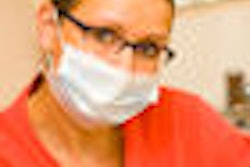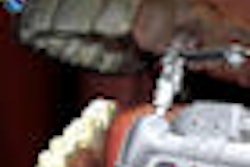
Part I of this series described how shifts in ethnicity and gender are shaping dentistry. Part II examines how dental schools are wrestling with these and other challenges.
Looking ahead, 28-year-old dental student Rhett Raum sees a future filled with complicated insurance forms and an expensive inventory. A fourth-year student at the University of Alabama School of Dentistry in Birmingham and vice president of the American Student Dental Association, Raum doesn't think his school is teaching enough about these subjects.
"If they get touched on, it's briefly, in a one-hour lecture," he said. "No one will sit them down and teach them."
It's a common complaint. When the American Dental Education Association (ADEA) polled students in 2006, it found that they thought their schools took too much time teaching basic medicine, behavioral issues, and periodontics and not enough on implant dentistry, orthodontics, and practice management.
To keep a dental office in the black these days, you just might need an M.B.A. But to get into some schools you have to prove you're more interested in community service. More and more dentists are placing implants, yet fewer and fewer dental students are studying prosthodontics.
As the face of dentistry changes, schools around the U.S. are struggling to adjust. Faced with a faculty shortage, they can't always teach what their students need to learn.
How to manage
Business administration has emerged as a particularly hot issue. Many dentists are flummoxed by constant changes in insurance plans, larger staffs of hygienists and assistants, and more expensive technology.
The curriculum at many schools doesn't address this information gap, according to Laura Neumann, the ADA's senior vice president of education and professional affairs. "Some schools try to have a simulated practice curriculum, but generally they focus on basic skills," she said. "There's not a lot of practice management, even though healthcare is becoming more business-oriented. That's where the curriculum will have to change, but there is a lot of resistance."
Dental schools aren't ignoring the problem purely out of traditionalism. With so much dental technique to impart, it's hard to fit practice management courses into the standard four years.
One solution is to study even harder. The University of California, San Francisco (UCSF) School of Dentistry allows students to earn an M.B.A. or business certificate at the nearby University of San Francisco (USF) while achieving their D.D.S. degree. The students study dentistry by day and business in the evening or during the summer. It's not only demanding but expensive; the M.B.A. program charges $50,000 above the cost of dental school.
How to serve
With the average tuition for one year of dental school reaching $40,000 and the average debt load for a dental student hitting $175,000, it's hard for graduates to focus on anything but a job that will help them make their loan payments.
Yet the people who need dentists the most are often those least able to pay. So dental schools are looking for ways to direct their graduates into community service.
A.T. Still University Arizona School of Dentistry & Oral Health, one of the newest dental schools in the U.S., downplays grade point averages and dental aptitude test (DAT) scores. It picks students based on who has already documented community service.
"They'll have a propensity to deliver community service in whatever career they choose," said the school's dean, Jack Dillenberg, D.D.S. Because of its Southwest locale, the school recruits American Indians from small communities and natives from rural areas who want to return home to practice.
For their final year, students spend half their time working in rural communities from Alaska to Maine. "They see up to 12 patients a day when most others see two or three a day, so we're giving them a tremendous amount of diversified learning," Dr. Dillenberg said. Of the first graduating class, 35% went to work in health centers. According to Dr. Dillenberg, 3,800 applicants vied for 60 spots last year.
These dentists aren't necessarily sacrificing their own economic well-being, Dr. Dillenberg said. "Community health service salaries start [around] $100,000, and because Indian Health Services has a 25% vacancy rate, they're also offering good salaries," he said.
Raum, the University of Alabama student, said his brother, a fellow dentist, opted to work with Indian Health Services, which offered a great salary plus some loan forgiveness.
"Then he got an offer to purchase a practice in a small town, which was a great decision for him, professionally and financially," he said. "A lot of students think they'll make less money in a rural area, but [they don't] think about the cost of living. All the areas within a 20-mile radius of dental schools are saturated with dentists, but outside of that is where you see the shortage. It's a lot more lucrative than they think."
Diversifying dentistry
Since dentists are more likely to serve the communities from which they come, dental schools are eager to recruit students from the groups that suffer most from oral diseases. Columbia University College of Dental Medicine is considering a program that might appeal to such students by combining bachelor's and dental degrees into seven years instead of the usual eight. In return, students would have to serve two years in an underserved community. "We hope many would choose to stay part or all of their career there," said Dennis Mitchell, D.D.S., associate dean for diversity and multicultural affairs.
Taking another approach to the problem, UCSF offers a one-year program targeting disadvantaged college students who failed to gain admission to dental school. In the seven years the program has existed, 99% of its students went on to dental school.
Many other dental schools are hoping to attract more students from underrepresented groups by reaching them before they start college. "Students in junior high have to start advanced prep for college, so we have to start at that age, too," Neumann said.
The ADEA found that students' primary influence for choosing a dentistry career was either their family dentist or a friend or relative who was a dentist. In the ADA's National Campaign for Dentistry, dentists are paired as mentors with kindergarten- to college-age students interested in dental careers, who do on-the-job shadowing and have regular sit-downs to get advice.
And in the ADA's new Student Ambassador Program, students take the lead in organizing mentor programs for minority students in college and high school. Marcus Johnson, a senior at the New York University College of Dentistry, co-founded Operation Dental Success, a program to steer minority students in middle and high schools to dentistry. Johnson, an African American from Denver, pursued dentistry because of the Hispanic dentist he had as a child. "I saw him as a regular person but I also saw how professional he could be and how people looked up to him."
He and fellow students mentor youngsters at racially mixed schools by focusing on how hygiene and diet connect to oral health. "Mentoring has an enormous influence on kids," he said.
How to compute
The technical demands of dentistry are changing as fast as the human ones. Half of all dental schools require students to have laptops, which they use while working on patients, and two-thirds have Web-based support and online classes, the ADEA found. Simulation, virtual reality, and digital radiography are more widely used in teaching.
The University of Maryland School of Dentistry in Baltimore, decended from the U.S.' oldest dental college, opened a new $142 million, 375,000-sq-ft building last summer, featuring digital computer displays at each workstation. The school's new goal is to examine dental implications of new technologies, such as how stem cell research could lead to tooth implants grown from the patient's DNA. Going further with the trend, Maryland is blending its dental school's graduate research program into the medical school's program.
"It's clear the future of dentistry is much more going to be aligned with medicine," said the school's dean, Christian Stohler, D.M.D., Dr.Med.Dent.
Likewise, A.T. Still University offers a basic science curriculum that teaches by body system instead of discipline. "Instead of physiology and biology, we focus on cardiovascular, nervous, muscular systems one week at a time," Dr. Dillenberg said. Students take part I of the national written board exam after one year instead of three years at most dental schools. They're also in a simulation clinic on the third day of school, compared to a semester or year later at others, then move to an 85-chair, high-tech clinic in their third year for 36 hours a week.
"All graduates complete multiple implants and are certified in laser dentistry, and we're the first to do that," Dr. Dillenberg said.
Indeed, many other schools have yet to catch on to the implant trend, said Howard Landesman, D.D.S., a former president of the American Board of Prosthodontics. "One of the biggest problems facing dental educators in is the inability to teach implant dentistry to students," he wrote in a recent letter to the Academy of Prosthodontics. "[I am] unaware of any dentistry school that teaches students that the treatment of choice, when possible, is to replace a missing tooth with an implant. Most D.D.S. programs offer a few hours of didactic instruction, a selective course, and the possibility of observing a surgical procedure."
Raum noted that, out of his class of 52, prosthodontics only has two students. "Most see it nonessential as a specialty background because they'll be doing crown and bridge work anyway." Orthodontics and pediatrics were most popular.
Who can teach it?
Dental schools sometimes can't teach the courses students need because they can't recruit faculty who know the material. For the past two years, more than 400 faculty positions have remained unfilled, many in general dentistry, pediatric dentistry, and prosthodontics. To make matters worse, much of the current staff will soon retire. The schools struggle to compete with the income dentists can make in private practice.
In response, some are trying to groom students in house or invite practicing alumni to return full or part time. John Williams, D.D.S., dean at the University of North Carolina at Chapel Hill School of Dentistry, allows his faculty to do private practice so they can supplement their salaries.
The ADEA recently formed a partnership with the Academy for Academic Leadership to attract future dental school faculty by training them in teaching methods and course planning. It is also working with the American Association for Dental Research to get students interested through the Academic Dental Careers Fellowship Program. Ten students nationwide are selected for a year-long program that includes a summer teaching seminar, a mentor at their school, and the ability to teach classes, prepare lectures, and run labs. "It's creating an attractive buzz," Wells said.
What the future holds
So when baby boomer dentists bring on young associates to groom for the future, what should they expect?
"The old sense of paying dues doesn't work for them," said the Neumann of the ADA. "They are willing to serve, but want to see an impact right away. They're also more team-oriented and collaborative, compared to older generations that worked and studied more in isolation."
They will embrace technology easily and more willingly, said Dr. Williams of UNC. "Not only in patient care like digital x-rays but through the entire practice. They'll make everything electronic from billing and accounting to patient records. Everything will be on computer instead of a paper filing system."
However, the fundamental values and commitment to oral health still holds very strong with them, he added.
"We recognize that looking at the tooth first is a gateway to the health of the entire body," Johnson said.


















